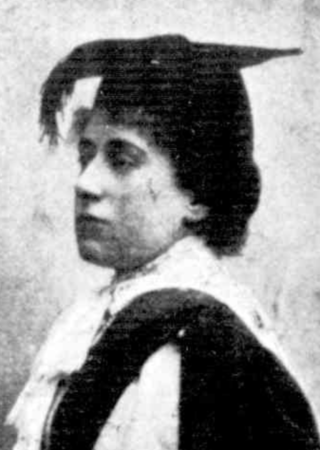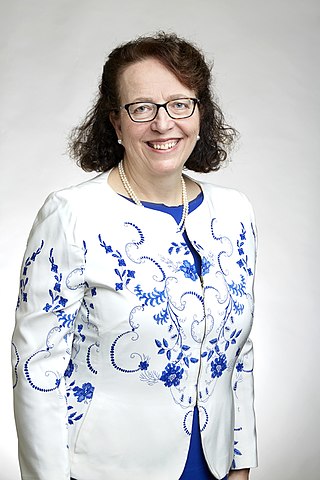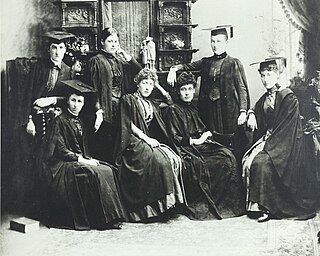
The Royal Children's Hospital (RCH), colloquially referred to as the Royal Children's, is a major children's hospital in Parkville, a suburb of Melbourne, Victoria, Australia. Regarded as one of the great Children's hospitals globally, the hospital and its facilities are internationally recognised as a “leading centre for paediatrics”. The hospital serves the entire states of Victoria, and Tasmania, as well as southern New South Wales and parts of South Australia. Patients from countries with a Reciprocal Health Agreement with Australia may be treated at the hospital, with seldom cases of overseas children being treated at the hospital.

Constance Ellis was an Australian medical doctor who specialised in obstetrics, gynaecology and pathology. In 1903 she became the first woman to graduate from the University of Melbourne as a Doctor of Medicine.

The Field Naturalists Club of Victoria (FNCV) is an Australian natural history and conservation organisation. The club is the oldest of its kind in Australia and is unique in having existed continuously since its foundation. Since its founding, the club has drawn its membership from the ranks of both amateur naturalists and professional scientists. This dual stream of members has continued into the 21st century, in which the club is well known for not only its scientific research output, but also numerous ongoing citizen science projects.

The Queen Victoria Hospital (QVH) was a hospital in Melbourne Victoria which founded in 1896, and closed in 1987. It was the first women's hospital in Victoria created by women, for women.
Dame Hilda Mabel Stevenson was an Australian philanthropist and community worker. She was the daughter of Hugh Victor McKay, a combine harvester inventor. She was the trustee and founder of the Sunshine Foundation.
Dame Phyllis Irene Frost was an Australian welfare worker and philanthropist, known for her commitment to causes, such as helping prisoners. She chaired the Victorian Women's Prisons Council for many years, established the Keep Australia Beautiful movement, worked for Freedom from Hunger and raised millions of dollars for charity.

Vera Scantlebury Brown OBE MBBS MD was an Australian medical practitioner and pediatrician in Victoria, Australia.
Charlotte Morrison Anderson was an Australian scientist, physician and academic. She pioneered the field of paediatric gastroenterology working on health issues including cystic fibrosis and coeliac disease. She was the first woman professor of paediatrics in the United Kingdom.
Dame Joyce Margaretta Daws DBE FRCS FRACS FAMA was an Australian-based British doctor who specialised in thoracic surgery at various hospitals for over twenty years, primarily in Melbourne. She held the post of Consultant Surgeon of Melbourne.

Dame Kate Isabel Campbell, DBE, FRCOG was a noted Australian physician and paediatrician. Campbell's discovery, that blindness in premature babies was caused by high concentrations of oxygen, resulted in the alteration of the treatment of premature babies world-wide and for this she received global recognition.
Jean Galbraith was an Australian botanist, gardener, writer of children's books and poet.

Ingrid Eileen Scheffer is an Australian paediatric neurologist and senior research fellow at the Florey Institute of Neuroscience and Mental Health. Scheffer has made several major advances in the field of epilepsy research. Scheffer is credited with finding the first gene implicated in epilepsy. She has also described and classified novel epileptic syndromes such as Epilepsy limited to Females with Mental Retardation.
Gretna Margaret Weste was a leading scientist noted for her work in plant pathology and mycology, specifically with Phytophthora cinnamomi.
The Victorian Medical Women's Society (VMWS) is the longest-running association of women medical practitioners and medical students. It was established in Melbourne, Australia in 1896 and is one of the oldest active medical organisations in the world. The aim of the society was to set a benchmark in women's health around Victoria, and to advance the professional development of medical women, through education, research, and the improvement of professional opportunities. The state-run society became affiliated with the national body, Australian Federation of Medical Women, and thereby the Medical Women's International Association.

Hannah Mary Helen Sexton MBBS, known as Helen Sexton, was an Australian surgeon. In 1887, she led a group of seven women to successfully petition the University of Melbourne to lift their ban on women enrolling in medicine. She completed her degree in 1892, and went on to co-found the Queen Victoria Hospital. After retiring from a surgical career in Melbourne, she opened a field hospital, Hôpital Australien de Paris, in France during World War I, achieving the rank of Major in the French Army.

Victoria Coffey was an Irish medical doctor and paediatrician. She was one of the first people to research sudden infant death syndrome (SIDS) and one of the first females to undertake significant research into congenital abnormalities. She also became the first female president of the Irish Paediatric Association, the paediatric section of the Royal Academy of Medicine in Ireland, the Royal College of Surgeons of Ireland (RCSI) Post-graduate Association, and the Irish American Pediatric Association. Coffey was also the first female recipient of the RCSI Distinguished Graduate medal.

Grace 'Clara' Stone was a medical doctor from Melbourne, Australia, who was one of the founders of the Queen Victoria Hospital and a co-founder, and the first president, of the Victorian Medical Women's Society. She was also in the group of seven women who successfully fought the ban against women studying medicine at Melbourne University in 1887, and one of the first two women to graduate as a doctor, in 1891.
Doris Lyne Officer OBE was an English-Australian physician and paediatrician.

Margaret Whyte MB BS was a medical doctor from Melbourne, Australia. She graduated as a doctor with the top grades in her class of 1891, and along with her classmate Clara Stone, this made them the first women to graduate as doctors in Victoria. While she qualified for a residency at the Royal Melbourne Hospital, she was denied her place because of her gender, and so took an appointment in 1892 at the Royal Women's Hospital instead. She was the first woman resident at the hospital.

Girlie George Chapple Hodges MBBS, MS was a surgeon from Melbourne, who was selected to play on the Australia women's national field hockey team during the 1920s and 1930s. She also played on the varsity and state levels, and was known as being fast and reliable on the wing. Hodges attended Melbourne University medical school, gaining her MBBS in 1931, and working at the Royal Melbourne Hospital, the Royal Children's Hospital, and the Queen Victoria Hospital as a medical doctor and surgical assistant. In 1939, she graduated with a Master of Surgery. She was the first woman to gain this degree in Victoria.










